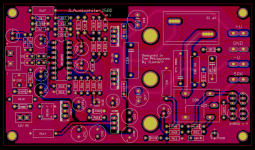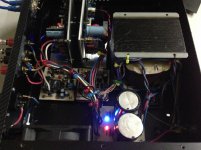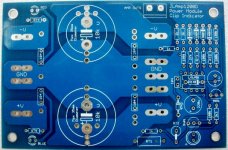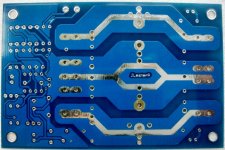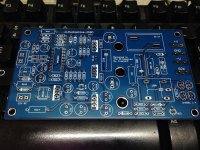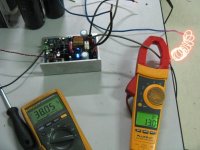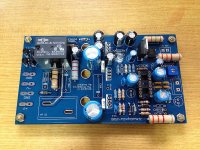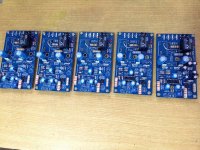Latest design... I changed the location of speaker protect supply input terminal, for easier access for different mounts. Added tank cap for VCC supply.
How is this new IRS2092 / IRAUDAMP7 board coming along? Did you order some prototype pcbs or are you still tweaking the layout/design?
-Charlie
D
Deleted member 148505
Hi Charlie,
I already sent the gerber files to the PCB fab. It will be here in 2 weeks
Attached the final design. The componenent legend is the same as IRAUDAMP7's schematic.
No Over/Under-voltage protection, no over temp protection. Osc Freq. can be adjusted via single turn pot.
I added negative bias clamping (as per AN1138) to prevent the damage to IRS2092 when negative supply is missing.
Added SMD bypass caps (bottom side of the PCB) right at the pins of VAA, VSS, VBS, VCC.
Regards,
Lester
I already sent the gerber files to the PCB fab. It will be here in 2 weeks
Attached the final design. The componenent legend is the same as IRAUDAMP7's schematic.
No Over/Under-voltage protection, no over temp protection. Osc Freq. can be adjusted via single turn pot.
I added negative bias clamping (as per AN1138) to prevent the damage to IRS2092 when negative supply is missing.
Added SMD bypass caps (bottom side of the PCB) right at the pins of VAA, VSS, VBS, VCC.
Regards,
Lester
Attachments
I like it! Almost all thru-hole components. The IRS2092 is thru hole too I think, right? This is something that even I could build. If I have to solder four SMD caps, I can handle that I guess.
I really like the IRS2092 based amps. Not having under or over voltage circuitry is actually a plus in my mind, since it lets you have more flexibility with the rail voltages.
I read in another thread recently how someone was having some odd problems with their class D amp. They finally tracked it down to the oscillator frequency control pot getting dirty and the resistance fluctuating with vibration or something. Do you think it is wise to leave the pot in?
Speaking of that, if I used several boards like this operating off of the same supply, do I need to worry about audible noise from beating (interference) between slightly different oscillator frequencies on each of the boards?
I really like the IRS2092 based amps. Not having under or over voltage circuitry is actually a plus in my mind, since it lets you have more flexibility with the rail voltages.
I read in another thread recently how someone was having some odd problems with their class D amp. They finally tracked it down to the oscillator frequency control pot getting dirty and the resistance fluctuating with vibration or something. Do you think it is wise to leave the pot in?
Speaking of that, if I used several boards like this operating off of the same supply, do I need to worry about audible noise from beating (interference) between slightly different oscillator frequencies on each of the boards?
D
Deleted member 148505
I like it! Almost all thru-hole components. The IRS2092 is thru hole too I think, right? This is something that even I could build. If I have to solder four SMD caps, I can handle that I guess.
I really like the IRS2092 based amps. Not having under or over voltage circuitry is actually a plus in my mind, since it lets you have more flexibility with the rail voltages.
I read in another thread recently how someone was having some odd problems with their class D amp. They finally tracked it down to the oscillator frequency control pot getting dirty and the resistance fluctuating with vibration or something. Do you think it is wise to leave the pot in?
Speaking of that, if I used several boards like this operating off of the same supply, do I need to worry about audible noise from beating (interference) between slightly different oscillator frequencies on each of the boards?
Thanks
Yes, it's all through hole, the 4 SMD bypass caps are just optional, they are not in IRAUDAMP7 schem but better if have them installed.
What thread is it? I think there won't be a problem if you use genuine bourns pot and seal the top with hotmelt glue after setting the osc freq.
Interference is not usually a problem specially if the d-amp is well implemented. If you'll use more than 2 channels make the amp's osc freq. 25kHz apart or If you don't have access to scope, replace the trimpot with jumper, use identical parts and 1% resistors on feedback and integration resistors, c0g caps on C4 and C6, so that the osc freq of the amps will be closely matched.
I'm making a BOM for this: >> here <<
What thread is it? I think there won't be a problem if you use genuine bourns pot and seal the top with hotmelt glue after setting the osc freq.
Actually it was a thread from this forum about a class AB amp. The pot was for setting the bias:
http://www.diyaudio.com/forums/soli...lme49830-lateral-mosfets-225.html#post3807065
I don't think that I would be able to match oscillator frequencies over multiple boards very closely. Especially when values drift with temperature and time... Your suggestion to make them all far apart (>25kHz) would be best I think. Since the osc. frequency is not critical, I don't see a problem with this approach.
I'm really not sure how much of a problem this is, only recall hearing that it COULD result in audible tones or noise from interference of the different oscillators...
Last edited:
D
Deleted member 148505
D
Deleted member 148505
Completing the JLAmp1200D Series:
- 1200W Class-D Amplifier
- Speaker Protect with Automatic Fan Control
- Softstart Circuit
- Linear Supply Module with Clipping Indicator.

- 1200W Class-D Amplifier
- Speaker Protect with Automatic Fan Control
- Softstart Circuit
- Linear Supply Module with Clipping Indicator.
- Accepts up to 35mm diameter capacitors (100V 10000uF).
- +- LED Indicators.
- Provision for bleeder resistors.
- 1 LED Clipping indicator for left and right channels.
- Small footprint: 2.6" x 4"
Attachments
D
Deleted member 148505
Hello jlester87, the beat frequency is presented in the class D amplifier is a reality when a switching power supply used.
with linear processors and you make no noise tests
PS: the above does not apply to the amp with IRS2092
Greetings ...
Haven't tested it yet with an SMPS. But I plan to buy an SMPS to test if my amp has audible noise when it is used..
Why does it not apply to IRS2092 based amp?
Why does it not apply to IRS2092 based amp?
Hello, does not apply to the IRS2092 because testing with a SMPS not hear noise,
the sound is good.
Get on with your project ..
D
Deleted member 148505
D
Deleted member 148505
D
Deleted member 148505
D
Deleted member 148505
Great amp!
Will you be selling the pcb's on your eBay site for this design?
Yes, I will only sell PCBs for JLAudiophile-250D because a fully assembled one will be heavy so it's not practical to ship because the courier charge here is expensive. Can't beat Chinese IRS2092 kits price+shipping because of that...
For power and performance vs price, my JLAmp1200D is hard to beat
Looks like a great amp! You should design a subwoofer control panel (Eq,gain, fase etc) for the 1200D series. So people could make their own Plate Amplifiers with total control. Would be awsome!
I am not planning to create a subwoofer controller because for serious DIY subwoofer builder, a DSP + USB measurement microphone will be the best tool to obtain a flat bass frequency response in a room.
SMPS to match
Jlester87,
What is needed is a SMPS to match this little beauty?
Could I suggest a design which includes a matching SMPS for the purpose of powerinh the JLAmp1200D. Anything on this forum which is suitable?
Looking for a replacement class D module to use to replace the bad designed Mackie SMA1500 subwoofer plate module. These are a 'Class G' powering a 12ohm 15" driver with 140V! Terrible design!!! and I have two which needs fixing and new speaker (all Open circuited) cooked.
The JLAmp1200D with a SMPS using the existing X-over simple enough to retrofit and use a standard Eminence Kappa Pro LF 4ohm driver.
Jlester87,
What is needed is a SMPS to match this little beauty?
Could I suggest a design which includes a matching SMPS for the purpose of powerinh the JLAmp1200D. Anything on this forum which is suitable?
Looking for a replacement class D module to use to replace the bad designed Mackie SMA1500 subwoofer plate module. These are a 'Class G' powering a 12ohm 15" driver with 140V! Terrible design!!! and I have two which needs fixing and new speaker (all Open circuited) cooked.
The JLAmp1200D with a SMPS using the existing X-over simple enough to retrofit and use a standard Eminence Kappa Pro LF 4ohm driver.
D
Deleted member 148505
Is it possible to bridge two amp boards for more output?
Yes you can, these are half-bridge designs. There's no onboard bridging circuit so you have to use an external one.
D
Deleted member 148505
Jlester87,
What is needed is a SMPS to match this little beauty?
Could I suggest a design which includes a matching SMPS for the purpose of powerinh the JLAmp1200D. Anything on this forum which is suitable?
Looking for a replacement class D module to use to replace the bad designed Mackie SMA1500 subwoofer plate module. These are a 'Class G' powering a 12ohm 15" driver with 140V! Terrible design!!! and I have two which needs fixing and new speaker (all Open circuited) cooked.
The JLAmp1200D with a SMPS using the existing X-over simple enough to retrofit and use a standard Eminence Kappa Pro LF 4ohm driver.
I can't really recommend any SMPS on this forum because I haven't tried one. But I think connexelectronic SMPSes are good and cheap.
If you'll do sine wave power test, you need an SMPS capable of 25A RMS output without going into protection mode.
If you'll just listen to music or use this for subwoofer, lower power ratings will suffice. Voltage should be max +-77VDC rail with single 15VDC independent / floating supply. SMPS Power rating will depend on your intended load, for example if you will use this to drive a 12ohm subwoofer, you just need a 250W SMPS. For 2 ohms load you need 1250W. Your goal in SMPS PSU sizing is that it shouldn't go into protection mode when you use it.
- Status
- Not open for further replies.
- Home
- Vendor's Bazaar
- Amplifier Modules and PCBs For Sale
